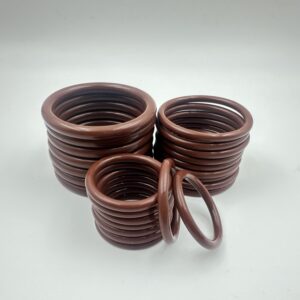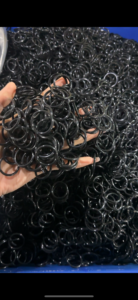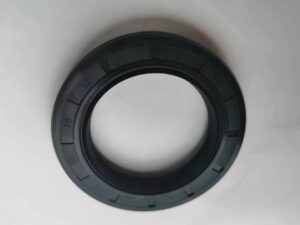Table of Contents
ToggleWhat is the Difference Between Oil Seal and O-Ring?
Oil seals and O-rings are both critical components in mechanical systems, designed to prevent leaks and ensure operational efficiency. However, their distinct designs, applications, and functionalities make them suitable for different scenarios. This article provides a comprehensive comparison to clarify their differences and guide optimal selection.




1. Design and Structural Differences
| Feature | O-Ring | Oil Seal |
| Shape | Circular ring with a round cross-section. | Cylindrical body with a metal casing, flexible sealing lip(s), and often a garter spring. |
| Components | Single elastomeric ring. | Multi-part assembly: rubber lip, metal casing, and spring for tension. |
| Installation | Compressed into a groove between two static or dynamic surfaces. | Pressed into a housing, with the sealing lip contacting a rotating shaft. |
Key Insight:
- O-rings rely on compression within a groove to create a seal.
- Oil seals use a spring-loaded lip to maintain contact with moving parts, ensuring consistent sealing under motion.
2. Functional Distinctions
O-Ring
- Primary Role:
- Seals interfaces between static (non-moving) or low-speed dynamic components (e.g., reciprocating pistons).
- Prevents bidirectional leakage of fluids (liquids or gases).
- Pressure Handling:
- Suitable for moderate pressure from both sides.
- Common Applications:
- Hydraulic systems, pipe fittings, fuel injectors, and pneumatic valves.
Oil Seal
- Primary Role:
- Retains lubricants (oil, grease) within a system while excluding contaminants (dirt, water, dust).
- Designed for unidirectional sealing in high-speed rotating applications (e.g., shafts, bearings).
- Pressure Handling:
- Manages higher pressure differentials, often retaining internal lubricant under stress.
- Common Applications:
- Automotive crankshafts, gearbox shafts, industrial pump bearings, and machinery with rotating components.
3. Application Scenarios
| Scenario | O-Ring | Oil Seal |
| Static Seals | Ideal for fixed connections (e.g., pipe flanges, caps). | Rarely used; not optimized for static environments. |
| Dynamic Seals | Effective in low-speed reciprocating or rotating motion (e.g., hydraulic pistons). | Optimized for high-speed rotating shafts (e.g., engines, turbines). |
| Environmental Needs | Works in moderate-temperature, non-abrasive conditions. | Excels in harsh environments with contaminants, high temperatures, or chemical exposure. |
4. Material and Durability Comparison
O-Ring Materials
- Nitrile (NBR): Oil-resistant, ideal for fuel systems.
- Silicone: Withstands extreme temperatures (-60°C to 230°C).
- Viton (FKM): Resistant to chemicals and high heat.
- EPDM: UV- and weather-resistant, suitable for outdoor applications.
Limitation: Prone to wear in high-friction dynamic setups due to constant compression and movement.
Oil Seal Materials
- Lip Material: Nitrile, polyacrylate (ACM), or fluoroelastomer (FKM) for chemical/heat resistance.
- Reinforcement: Metal casing provides structural rigidity.
- Spring Mechanism: Maintains lip contact pressure on shafts, enhancing durability.
Advantage: Superior abrasion resistance in continuous rotation, ensuring longer lifespan in demanding applications.
5. Key Differences Summary
| Aspect | O-Ring | Oil Seal |
| Sealing Focus | General-purpose static/dynamic sealing. | Specialized for rotating shafts; retains lubricants and blocks contaminants. |
| Pressure Direction | Bidirectional. | Unidirectional (retains internal pressure). |
| Cost | Low-cost, simple design. | Higher cost due to complex multi-part structure. |
| Lifespan | Shorter in high-friction applications. | Longer lifespan in high-speed or abrasive environments. |
6. Selection Guidelines
When to Use an O-Ring
- Sealing static joints or low-speed dynamic components.
- Applications requiring bidirectional pressure resistance.
- Budget-conscious projects with minimal environmental stress.
Examples: Plumbing systems, hydraulic cylinders, compressed air valves.
When to Use an Oil Seal
- Sealing rotating shafts or bearings in engines, gearboxes, or pumps.
- Critical environments requiring lubricant retention and contaminant exclusion.
- High-speed or high-pressure industrial machinery.
Examples: Automotive crankshafts, conveyor belt rollers, wind turbine gearboxes.
7. Real-World Applications
O-Ring Use Cases
- Hydraulic Systems: Seals piston chambers to prevent fluid leakage.
- Plumbing: Ensures watertight connections in pipe fittings.
- Aerospace: Used in fuel and oxygen systems for static sealing.
Oil Seal Use Cases
- Automotive Engines: Seals crankshafts to retain engine oil.
- Industrial Pumps: Protects bearings from abrasive particles in wastewater systems.
- Food Processing: Prevents lubricant contamination in rotating machinery.
8. Conclusion: Choosing the Right Seal
While both O-rings and oil seals prevent leaks, their applications diverge significantly:
- O-rings excel in simplicity and versatility for static or low-motion systems.
- Oil seals are engineered for durability in high-speed, high-stress rotating environments.
Final Considerations:
- Motion Type: Use O-rings for limited movement; opt for oil seals in rotational applications.
- Environmental Stress: Oil seals outperform in abrasive or chemically aggressive settings.
- Cost vs. Performance: Balance budget constraints with operational demands.
Understanding these differences ensures optimal seal selection, enhancing system reliability, reducing downtime, and extending equipment lifespan.



Leave A Comment